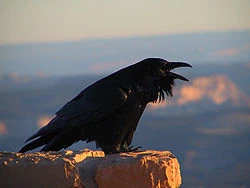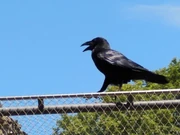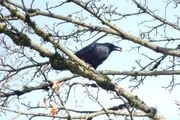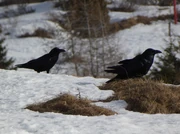| Common Raven | |
|---|---|
 | |
| Scientific classification | |
| Kingdom: | Animalia |
| Phylum: | Chordata |
| Class: | Aves |
| Order: | Passeriformes |
| Family: | Corvidae |
| Genus: | Corvus |
| Species: | Corvus corax |
The Common Raven (Corvus corax) is a large, all-black passerine bird. Found across the northern hemisphere, it is the most widely distributed of all corvids. It is possibly the heaviest passerine bird; at maturity, the Common Raven is between 56 and 69 cm (22 to 27 inches) in length, with recorded weights ranging from 0.69 to 1.63 kg (1.5 to 3.6 pounds). Common Ravens typically live about 10 to 15 years in the wild, although lifespans of up to 40 years have been recorded. Young birds may travel in flocks, but later mate for life, with each mated pair defending a territory.
Description[]

one of the ravens of the Tower of London.
A mature Common Raven is between 56 and 69 cm (22 to 27 inches) in length, with a wingspan of 115 to 130 cm (45 to 51 in). Recorded weights range from 0.69 to 1.63 kg (1.5 to 3.6 lb), making it one of the heaviest passerines. The bill is large and slightly curved. It has a longish, strongly graduated tail, mostly black iridescent plumage, and a dark brown iris. The throat feathers are elongated and pointed and the bases of the neck feathers are pale brownish-grey. Juvenile plumage is similar but duller with a blue-grey iris.
Apart from its greater size, the Common Raven differs from its cousins, the crows, by having a larger and heavier beak, a shaggy throat, and a wedge-shaped tail. The species has a distinctive, deep, resonant prruk-prruk-prruk call, which to experienced listeners is unlike that of any other corvid. Its very wide and complex vocabulary includes a high, knocking toc-toc-toc, a dry, grating kraa, a low guttural rattle and some calls of an almost musical nature. In flight the feathers produce a creaking sound that has been likened to the rustle of silk.
Common Ravens can be very long-lived, especially in captive or protected conditions; individuals at the Tower of London have lived for more than 40 years. Lifespans in the wild are considerably shorter: typically only 10 to 15 years. The longest known lifespan of a banded wild Common Raven was 13 years.
Behaviour[]
Common Ravens usually travel in mated pairs, although young birds may form flocks. Relationships between Common Ravens are often quarrelsome, yet they demonstrate considerable devotion to their families.
Diet[]
Common Ravens are omnivorous and highly opportunistic: their diet may vary widely with location, season and serendipity.

Common Raven with food in mouth
In some places they are mainly scavengers, feeding on carrion as well as the associated maggots and carrion beetles. Plant food includes cereal grains, berries and fruit. They prey on small invertebrates, amphibians, reptiles, small mammals and birds. Ravens may also consume the undigested portions of animal feces, and human food waste. They store surplus food items, especially those containing fat, and will learn to hide such food out of the sight of other Common Ravens.
Common Ravens nesting near sources of human garbage included a higher percentage of food waste in their diet, birds nesting near roads consumed more road-killed vertebrates, and those nesting far from these sources of food ate more arthropods and plant material. Fledging success was higher for those using human garbage as a food source.
One behavior is recruitment, where juvenile ravens call other ravens to a food bonanza, usually a carcass, with a series of loud yells. IA more mundane explanation is that individuals co-operate in sharing information about carcasses of large mammals because they are too big for just a few birds to eat. Experiments with baits however show that such recruitment behaviour is independent of the size of the bait.
Breeding[]

A pair of Common Ravens in the snow.
Juveniles begin to court at a very early age, but may not bond for another two or three years. Aerial acrobatics, demonstrations of intelligence, and ability to provide food are key behaviors of courting. Once paired, they tend to nest together for life, usually in the same location. Sexual infidelity has been observed in Common Ravens, by males visiting a female's nest when her mate is away.
Breeding pairs must have a territory of their own before they begin nest-building and reproduction, and thus aggressively defend a territory and its food resources. Nesting territories vary in size according to the density of food resources in the area. The nest is a deep bowl made of large sticks and twigs, bound with an inner layer of roots, mud, and bark and lined with a softer material, such as deer fur. The nest is usually placed in a large tree or on a cliff ledge, or less frequently in old buildings or utility poles.
Females lay between three to seven pale bluish-green, brown-blotched eggs. Incubation is about 18 to 21 days, by the female only. However, the male may stand or crouch over the young, sheltering but not actually brooding them. Young fledge at 35 to 42 days, and are fed by both parents. They stay with their parents for another six months after fledging.
In most of their range, egg laying begins in late February. In colder climates, it is later, e.g. April in Greenland and Tibet. In Pakistan, egg-laying takes place in December. Eggs and hatchlings are rarely preyed on by large hawks and eagles, large owls, martens and canids. The adults, with no known natural predators, are often successful in defending their young from these predators, due to their numbers, large size and cunning.They have been observed dropping stones on potential predators that venture close to their nests.
Vocalization[]
Like other corvids, Ravens can mimic sounds from their environment, including human speech. They have a wide range of vocalizations, which remain an object of interest to ornithologists. Gwinner carried out important studies in the early 1960s, recording and photographing his findings in great detail.
Fifteen to 30 categories of vocalization have been recorded for this species, most of which are used for social interaction. Calls recorded include alarm calls, chase calls, and flight calls. Non-vocal sounds produced by the Common Raven include wing whistles and bill snapping. Clapping or clicking has been observed more often in females than in males. If a member of a pair is lost, its mate reproduces the calls of its lost partner to encourage its return.
Intelligence[]
The brains of Common Ravens count among the largest of any bird species. Specifically, their hyperpallium is large. For a bird, they display ability in problem solving, as well as other cognitive processes such as imitation and insight.
One experiment designed to evaluate insight and problem-solving ability involved a piece of meat attached to a string hanging from a perch. To reach the food, the bird needed to stand on the perch, pull the string up a little at a time, and step on the loops to gradually shorten the string. Four of five Common Ravens eventually succeeded, and "the transition from no success (ignoring the food or merely yanking at the string) to constant reliable access (pulling up the meat) occurred with no demonstrable trial-and-error learning" This supports the hypothesis that Common Ravens are 'inventors'; that is, they have the ability to solve problems presented to them. Many of the Common Raven's problem-solving skills were formerly thought to be instinctive, but it is becoming clear that Common Ravens are actually quite intelligent.
They watch where other Common Ravens bury their food and remember the locations of each other's food caches, so they can steal from them. This type of theft occurs so regularly that Common Ravens will fly extra distances from a food source to find better hiding places for food. They have also been observed pretending to make a cache without actually depositing the food, presumably to confuse onlookers.
Common Ravens living in urban environments have been known to drop nuts that they are incapable of cracking open with their beaks into busy road intersections. They allow the traffic to drive over them, crushing the nuts. When the traffic stops, they swoop down and pick up the nuts to eat.
Common Ravens are known to steal and cache shiny objects such as pebbles, pieces of metal, and golf balls. One theory is that they hoard shiny objects to impress other ravens. Other research indicates that juveniles are deeply curious about all new things, and that Common Ravens retain an attraction to bright, round objects based on their similarity to bird eggs. Mature birds lose their intense interest in the unusual, and become highly neophobic.
Playful behavior[]
In recent years, biologists have recognized that birds engage in play. Juvenile Common Ravens are among the most playful of bird species. They have been observed to slide down snowbanks, apparently purely for fun. They even engage in games with other species, such as playing catch-me-if-you-can with wolves and dogs. Common Ravens are known for spectacular acrobatic displays, such as flying in loops or interlocking talons with each other in flight.
They are also one of only a few species who make their own toys. They have been observed breaking off twigs to play with socially.
Distribution and Habitat[]
Common Ravens can thrive in varied climates; indeed this species has the largest range of any member of the genus. They range throughout the Holarctic from Arctic and temperate habitats in North America and Eurasia to the deserts of North Africa, and to islands in the Pacific Ocean. In the British Isles, they are more common in Scotland, Wales, northern England and the west of Ireland.
Most Common Ravens prefer wooded areas, with large expanses of open land nearby, or coastal regions for their nesting sites and feeding grounds. In some areas of dense human population, such as California in the United States, they take advantage of a plentiful food supply and have seen a surge in their numbers.
